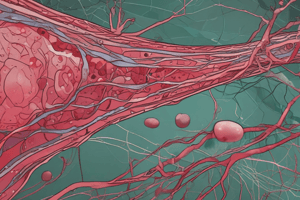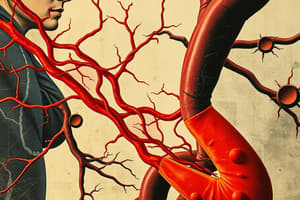Podcast
Questions and Answers
Which of the following is NOT a proposed risk factor for atherosclerosis?
Which of the following is NOT a proposed risk factor for atherosclerosis?
- Smoking
- Asthma (correct)
- Sedentary lifestyle
- Hyperlipidemia
What are the classic manifestations of acute arterial obstruction?
What are the classic manifestations of acute arterial obstruction?
- Pallor, pain, perspiration
- Pain, pulselessness, pallor
- Temperature, tenderness, tachycardia
- Pallor, paresthesia, paralysis (correct)
Which of the following conditions is most commonly a cause of venous obstruction?
Which of the following conditions is most commonly a cause of venous obstruction?
- Incompetent valves (correct)
- Arterial plaque buildup
- Elevated blood pressure
- Thrombocytopenia
What is a key complication associated with deep vein thrombosis?
What is a key complication associated with deep vein thrombosis?
What is a common result of obstructed lymph flow?
What is a common result of obstructed lymph flow?
What is the innermost layer of arteries and veins called?
What is the innermost layer of arteries and veins called?
Which factor has the greatest influence on the resistance to blood flow?
Which factor has the greatest influence on the resistance to blood flow?
According to Laplace's law, what happens when the radius of a vessel increases?
According to Laplace's law, what happens when the radius of a vessel increases?
What primarily determines the permeability of capillaries?
What primarily determines the permeability of capillaries?
What is the formula that summarizes the relationship between blood flow, pressure, and resistance?
What is the formula that summarizes the relationship between blood flow, pressure, and resistance?
What occurs when wall tension overcomes distending pressure in a blood vessel?
What occurs when wall tension overcomes distending pressure in a blood vessel?
In which part of the circulatory system does blood flow the slowest?
In which part of the circulatory system does blood flow the slowest?
Which of the following best describes the process of diffusion in relation to capillary exchange?
Which of the following best describes the process of diffusion in relation to capillary exchange?
What effect does increased capillary fluid pressure have on filtration?
What effect does increased capillary fluid pressure have on filtration?
How does the sympathetic nervous system affect blood flow in vascular beds?
How does the sympathetic nervous system affect blood flow in vascular beds?
What is autoregulation in the context of blood flow?
What is autoregulation in the context of blood flow?
What typically results from obstructive processes in blood vessels?
What typically results from obstructive processes in blood vessels?
What is a common consequence of arterial obstruction?
What is a common consequence of arterial obstruction?
Which of the following is considered a cause of vessel obstruction?
Which of the following is considered a cause of vessel obstruction?
What is primarily responsible for lymphedema?
What is primarily responsible for lymphedema?
What is the most common cause of chronic progressive arterial obstruction?
What is the most common cause of chronic progressive arterial obstruction?
Study Notes
Blood Vessel Structure
- Arteries, veins, and capillaries have distinctive structures.
- Arteries and veins share three layers: intima, media, and adventitia.
- Artery media is thicker than vein media due to smooth muscle and elastin content.
- Capillaries are composed of a single layer of endothelial cells lining a basement membrane.
Blood Flow Principles
- Blood flow is governed by physical laws.
- Flow is directly proportional to pressure and inversely proportional to resistance.
- Blood pressure is the product of cardiac output and resistance.
- Resistance is influenced by vessel radius (most significant), length, blood viscosity, and turbulence.
- Vessel radius has an inverse, fourth-power relationship with resistance, meaning a small change in radius significantly affects resistance.
- Blood flow velocity is inversely proportional to the total cross-sectional area of the vascular bed. Capillaries have the slowest flow due to their large combined area.
Mechanisms for Regulating Blood Flow
- Both the autonomic nervous system (centrally) and local tissues (locally) regulate blood flow.
- In most cases, the sympathetic nervous system (SNS) constricts blood vessels via α-1 receptors on smooth muscle cells, which respond to norepinephrine.
- Parasympathetic innervation of systemic vessels is insignificant.
- Autoregulation allows tissues to maintain optimal blood flow despite pressure changes.
- Autoregulation involves constriction of arterioles and precapillary sphincters during high pressure or reduced demand, and dilation during low pressure or high demand.
- Lymphatic vessels contract when stretched, promoting flow and preventing backflow with valves. External muscle contraction assists lymph flow.
Common Causes of Altered Blood Flow
- Obstruction is a leading cause of altered blood flow, decreasing flow downstream from the obstruction and increasing pressure upstream.
- Arterial obstruction results in distal ischemia, while venous obstruction causes edema.
- Causes of vessel obstruction include thrombi, emboli, vasospasm, external compression (e.g., compartment syndrome), and structural changes (e.g., atherosclerosis, aneurysms).
- Edema can arise from pressure changes within the circulatory system or interstitium, while lymphatic system impairment leads to lymphedema.
Arterial Flow Alterations
- Common causes of arterial obstruction include:
- Atherosclerosis
- Inflammation
- Vasospasm
- Aneurysms
- Emboli are the primary cause of acute arterial occlusion.
- Atherosclerosis is the most common cause of chronic progressive arterial obstruction.
- Risk factors for atherosclerosis:
- Smoking
- Hyperlipidemia
- Male sex
- Advancing age
- Sedentary lifestyle
- Obesity
- Glucose intolerance
- Family history of cardiovascular disease
- Acute arterial obstruction presents with the classic "six Ps": pallor, paresthesia, paralysis, pain, pulselessness, and polar (cold to touch).
Venous Flow Alterations
- Common causes of venous obstruction:
- Incompetent valves (often due to obesity, pregnancy, right heart failure, or prolonged standing), leading to varicose veins and chronic venous insufficiency.
- Obstruction by deep vein thrombosis (DVT).
- Edema, venous stasis ulcers, and pain are typical symptoms of chronic venous obstruction.
- Deep vein thrombosis (DVT) poses a serious risk of pulmonary embolism due to potential embolization to the lungs, requiring prompt anticoagulation therapy.
Alterations in Lymphatic Flow
- Lymphatic flow obstruction is usually caused by:
- Surgical removal of lymphatic vessels
- Radiation damage to lymphatic vessels during cancer treatment
- Lymphatic obstruction manifests as regional edema and thickened subcutaneous tissue.
Studying That Suits You
Use AI to generate personalized quizzes and flashcards to suit your learning preferences.
Related Documents
Description
Explore the intricate structure of arteries, veins, and capillaries. Understand how physical laws govern blood flow, including the relationships between pressure, resistance, and vessel radius. This quiz will enhance your knowledge of cardiovascular physiology.




